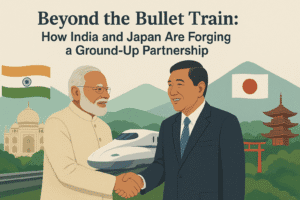Beyond the Bullet Train: How India and Japan Are Forging a Ground-Up Partnership
During his visit to Japan, Prime Minister Narendra Modi helped launch a groundbreaking ‘State-Prefecture Initiative’ to deepen ties between the two nations. This strategy moves beyond federal agreements to foster direct partnerships between India’s dynamic states and Japan’s innovative prefectures. The concrete goal is an annual exchange of delegations to fuel collaboration in technology, manufacturing, and SME innovation. This ground-up approach is designed to translate official agreements into tangible people-to-people prosperity and shared growth. By connecting regional powerhouses, it aims to unlock opportunities for startups and small businesses often left out of large deals. The ultimate vision is for these local alliances to co-pilot a new, more resilient chapter of India-Japan relations built on practical, human-centric exchange.

Beyond the Bullet Train: How India and Japan Are Forging a Ground-Up Partnership
While the image of Indian Prime Minister Narendra Modi riding Japan’s famed Shinkansen bullet train with his counterpart is a powerful symbol of high-speed futures, a quieter, more profound initiative was launched during his recent visit to Japan. This initiative, focused on the sub-national level, could be the real engine for a transformative partnership between the two nations.
Moving beyond traditional, top-down government agreements, Modi and former Japanese PM Shigeru Ishiba inaugurated the ‘India-Japan State-Prefecture Permanent Initiative’. Its goal is simple in concept but revolutionary in potential: to ensure that the dynamic states of India and the innovative prefectures of Japan become the primary hubs of international cooperation.
The “Powerhouses” Unite: Why This Level Matters
In a meeting with 16 Japanese governors, whom he rightly called “powerhouses of technology, manufacturing, and innovation,” Modi laid out a compelling vision. National agreements often set the stage, but real economic and cultural exchange happens on the ground—between businesses, universities, and communities.
Japanese prefectures like Aichi (home to Toyota) or Hyogo are globally recognized clusters of excellence. Similarly, Indian states like Gujarat, Tamil Nadu, and Maharashtra are themselves massive economic engines, each with unique specializations, from fintech to pharmaceuticals.
This initiative recognizes that strength and seeks to create a structured framework for these “powerhouses” to connect directly. The tangible goal? For at least three Indian states and three Japanese prefectures to exchange delegations every single year, moving beyond ceremonial visits to actionable partnerships.
From Paper to People to Prosperity: The Real Human Impact
The most insightful part of Modi’s address was his call for these partnerships to move “from paper to people to prosperity.” This phrase captures the entire ethos of the initiative. It’s an acknowledgment that past agreements have sometimes remained just that—agreements on paper.
The new focus is on creating real-world impact in key areas:
- For Startups and SMEs: This is perhaps the most exciting aspect. While large corporations have the resources to navigate international markets, small and medium enterprises (SMEs) and startups often do not. By creating prefecture-state channels, a tech startup in Fukuoka can more easily find a partner in Bengaluru’s thriving tech ecosystem. An artisan MSME (Micro, Small & Medium Enterprise) in a smaller Indian town can access Japanese craftsmanship and quality standards, elevating its product for global markets.
- Skill and Knowledge Flow: It’s not just about trade. It’s about ideas. Japanese prefectures possess deep expertise in advanced manufacturing, waste management, and disaster resilience. Indian states are hubs of IT innovation, frugal engineering, and a vast young talent pool. The cross-pollination of these skills can solve local problems with global solutions.
- Cultural Threads as Economic Bridges: Strong cultural understanding fosters better business. As sub-national delegations exchange, so do their people, food, art, and traditions. This builds the trust and mutual respect that is the bedrock of any long-term commercial relationship.
Existing Foundations and Future Blueprints
The initiative is not starting from zero. Modi highlighted existing partnerships:
- Gujarat and Hyogo/Shizuoka (industrial and port synergies)
- Uttar Pradesh and Yamanashi (which cooperated on the landmark bullet train project)
- Maharashtra and Wakayama
- Andhra Pradesh and Toyama
These existing relationships provide a blueprint. The challenge and opportunity now are to scale this model, making such partnerships the norm rather than the exception.
The Bottom Line for the Reader
For observers of global economics, this represents a sophisticated shift in diplomatic strategy. It’s a move towards “glocalization” in international relations—leveraging global partnerships to fuel local development.
For businesses, entrepreneurs, and professionals in both countries, this initiative signals a practical pathway to new opportunities. It suggests that the next decade of India-Japan relations will be written not just in the corridors of power in New Delhi and Tokyo, but in the collaboration between a tech incubator in Hiroshima and one in Hyderabad, between a manufacturing SME in Osaka and its counterpart in Pune.
By empowering its states and prefectures to “co-pilot” progress, India and Japan are building a partnership that is more resilient, more innovative, and ultimately, more human.
You must be logged in to post a comment.